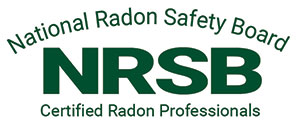RMT EXAM GUIDANCE
Radon Measurement Technician Course Curriculum (1)
One-Day Course
Revised July 1, 2001
A minimum of eight hours of classroom instruction time is required for this course. A maximum of one and a half hours is allowed for a 75 question closed book examination. Only after a student finishes the classroom portion of the course, may he/she sit for the examination. The class room work and the examination may be completed on the same day or the examination may be completed on a subsequent day.
A student must answer at least 70.65% (53 of 75) examination questions correctly to obtain a passing grade.
Determining the amount of time allocated to the various sections of this curriculum is not mandated; this determination is left to the discretion of the instructor. It is not mandated that all eight hours of classroom instruction be completed in a single day. However, to provide guidance for the instructor, the course curriculum indicates the approximate number of examination questions that will be associated with each section of the curriculum.
The course instructor must maintain a classroom attendance log for each student, which accounts for the time the student spent in the classroom.
I. Basic Concepts (9 questions)
- Radioactivity
- Radiation – alpha, beta, gamma
- Half-life
- Inert gas
- Uranium (mineral) > Radium (mineral) > Radon (gas) > Progeny (solids)
- Radon progeny
- Units: pCi/l, WL, Bq/m3, WLM
- Typical concentrations indoor/outdoor
- Action level
- Gas transport:
- From soil: diffusion, permeation, mixing/dilution
- From water: dissolution/aeration
- Sources: soil, rock, building materials, water
- Radon entry into house
(1) Based on “A Radon Curriculum for Professional Home Inspectors,” presented by Stephen Shefsky and Robert Juliano at the 1998 AARST International Symposium.
II. Health Effects (9 questions)
- Gas > progeny > (attachment) > lungs > alpha radiation > lung cancer risk
- Dose-response model
- Evidence of radon link to lung cancer (miner studies)
- Residential studies
- Extrapolating mines to homes
- Radon-in-water > aeration > inhalation > lungs > known risk
- Radon-in-water > ingestion > stomach/intestines/bloodstream > risk (?)
- Synergistic effect with smoking
- Risk at EPA action level
- What level is “safe”?
- Comparative risks: auto accidents, drowning, other radiation exposures, etc.
- If you don’t know the answer refer client to EPA or State
III. Radon Test Methods (9 questions)
- Test purposes: screening, follow-up/confirm, diagnostic, post-mitigation, maintenance, research/other
- Duration: long term, short term, grab
- Strategy: passive, active
- Integrating vs. continuous
- Screening protocol goals
- Devices: passive/ active, short term/long term
- Passive: Short Term: AC, LS, ES
- Active: Short Term: CR, CW
- Passive: Long Term: AT, EL
IV. Test Placement and Conditions (19 questions)
- Variation: diurnal, seasonal, spatial, weather-related, occupant-related
- Placement: level, room, location, how many
- Minimum distances
- Closed House Conditions
- When required? When recommended?
- Requirements for Closed House Conditions
- Notifying occupants
- Interference/tampering: detecting, avoiding
- Test invalidation
- Data reported to lab with test kit
- EPA Protocol for real estate transactions
- Interpretation of results
- Measurement error /uncertainty
- Large buildings, schools
- Discussion
- (Recommended) Radon-in-water sampling
V. Mitigation (5 questions)
- Mitigation strategies: basics
- Radon from soil:
- Soil depressurization: greatly reduces radon entry into house
- Ventilation: dilutes radon that has entered the house
- Other: sealing – usually doesn’t work by itself
- Radon from water:
- Aeration
- GAC filtration
- Comparative performance and costs
- Difficult situations
- Don’t offer mitigation strategies, let mitigators determine strategies
- All houses can be fixed – cost is the issue
- Radon resistant new construction
- Post-mitigation testing, system monitoring, and maintenance
VI. Relation with Client (9 questions)
- Dialogue with client
- Risk communication
- Confidentiality
- Interpretation of results for client
- Based on radon test results, what should be done next?
- Do nothing, retest, or call mitigator(s)
- If unusually high radon concentrations, urge client to call EPA or state for advice
- What follow-up is required?
- Real estate transaction
- Re-test when?
- Who pays for mitigation?
- Negotiation and escrow possibilities
- Discussion
VII. Relation with Laboratory (5 questions)
- Choosing lab
- Levels of service
- Division of responsibilities
- Quality assurance responsibilities
- Blanks, duplicates, spikes, calibrations
- Quality assurance plan
VIII. Role of Government (5 questions)
- Federal: EPA
- States: unregulated and regulated
- Regional review of state laws
- Real estate disclosure laws
- Radon outreach programs
- EPA Publications:
- Citizen’s Guide to Radon
- Consumer’s Guide to Radon Reduction
- Home Buyers and Sellers Guide to Radon
IX. Tester’s Health and Safety, Professional Conduct, and Ethics (3 questions)
- Testing in houses with known high radon concentrations
- Professional Conduct
- Ethics
X. Additional Courses, Continuing Education, and Credentials (2 questions)
- Advanced measurement methods
- Analytical services and quality assurance
- Radon in water
- Radon mitigation standards; and inspecting mitigation systems
- Video courses
- AARST programs
- NRSB Certification
- Other Certification Programs
